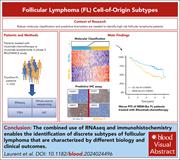Issue Archive
Table of Contents
BLOOD COMMENTARIES
REVIEW ARTICLE
T-cell lymphomas in recipients of CAR-T cells: assessing risks and causalities
As the number of recipients of chimeric antigen receptor (CAR) T-cell therapies has rapidly increased, sporadic reports of T-cell lymphomas arising de novo posttherapy have come to light. Hu and Dunbar critically review the literature, highlighting a small number of cases where vector insertions have been proven in T-cell lymphomas. They discuss the rare but real risk of insertional mutagenesis as well as other more common contributing factors, including immune dysregulation, preexisting clonal hematopoiesis, and T-cell clonal expansions.
HOW I TREAT
How I approach intersectionality in hematopoietic stem cell transplantation
Intersectionality refers to a framework focusing on how multiple axes of social inequality need to be considered when social determinants of health in our patients are assessed. Hamad identifies how these considerations can be very important in optimizing health care outcomes for people undergoing stem cell transplantation, using 3 cases to illustrate factors that physicians and health care systems should be actively recognizing.
CLINICAL TRIALS AND OBSERVATIONS
Baseline immune state and T-cell clonal kinetics are associated with durable response to CAR-T therapy in large B-cell lymphoma
Clinical Trials & Observations
Identifying the factors that predict durable responses to chimeric antigen receptor (CAR) T-cell therapy should allow improved patient selection. Maurer et al used serial multiomic analyses to identify predictors of response at 1 year to axicabtagene ciloleucel. As well as finding that CAR T-cell products enriched for clonally expanded T effector memory cells are associated with durable remissions, they report and validate an applicable 2-factor predictive model based on peripheral blood parameters measured on the day of apheresis.
LYMPHOID NEOPLASIA
Follicular lymphoma comprises germinal center–like and memory-like molecular subtypes with prognostic significance
Clinical Trials & Observations
Unlike diffuse large B-cell lymphoma, there is no genetic classifier for follicular lymphoma (FL) used in routine practice. Laurent and colleagues dissect the molecular heterogeneity of FL and present a new clinically applicable model that captures the biological diversity of the disease. This new cell-of-origin–based model appears prognostic for rituximab-chemotherapy–treated patients and may allow the identification of patients who could benefit from lenalidomide-based therapy in the frontline setting.
RED CELLS, IRON, AND ERYTHROPOIESIS
Rates of strokes in Californians with sickle cell disease in the post-STOP era
Clinical Trials & Observations
Ischemic stroke is a feared complication of sickle cell disease (SCD), and routine interventions (hydroxyurea and transfusions) that reduce its occurrence are widely available in the United States. However, Oluwole et al report that at a population level the incidence of stroke in people with SCD, both children and adults, has increased over time rather than decreased as had been expected. Their data provide a call for action for better application of existing approaches and emphasis on modifiable risk factors like hypertension and hyperlipidemia.
THROMBOSIS AND HEMOSTASIS
Complement biosensors identify a classical pathway stimulus in complement-mediated thrombotic microangiopathy
Complement-mediated thrombotic microangiopathy (CM-TMA), also known as atypical hemolytic uremic syndrome, is generally considered to be a disease triggered by genetic or immune dysregulation of the alternative complement pathway, yet a cause is not found in approximately 40% of patients. Cole and colleagues employed a novel cellular “biosensor” assay and reveal that polyreactive immunoglobulin M (IgM) present in the serum of patients with CM-TMA, both with or without known alternative pathway abnormalities, can initiate classical complement pathway activation. These provocative data indicate that CM-TMA is a multihit disease, triggered in some cases by classical pathway activation by IgM, and position this new assay for future use in clinical care.
Procoagulant platelet activation promotes venous thrombosis
Brief Report
Platelet stimulation results in the formation of 2 activated platelet subpopulations with distinct phenotypes, aggregatory and procoagulant, with the latter displaying externalization of negatively charged phospholipids to facilitate coagulation complex assembly. Using elegant murine models, Kaiser and colleagues show that platelets participate in venous thrombosis (VT) through their activation to a procoagulant phenotype and that procoagulant platelets are elevated in patients with VT. Pharmacologic inhibition of procoagulant platelet formation reduced venous thromboembolism in preclinical models, suggesting that drugs that inhibit the procoagulant phenotype warrant clinical evaluation for prevention of VT.
LETTER TO BLOOD
Pretransplant MRD detection of fusion transcripts is strongly prognostic in KMT2A-rearranged acute myeloid leukemia
BLOOD WORK
ERRATUM
RETRACTION
-
Cover Image
Cover Image
![issue cover]()
Immunofluorescence staining of a murine thrombus after suture-induced flow reduction of the inferior vena cava shows enrichment of procoagulant platelets in venous thrombosis. Green, fibrinogen; red, CD41 (platelets); white, phosphatidylserine; blue, nuclei. See the article by Kaiser et al on page 2546.
- PDF Icon Front MatterFront Matter
- PDF Icon Table of ContentsTable of Contents
- PDF Icon Editorial BoardEditorial Board
Advertisement intended for health care professionals
Email alerts
Advertisement intended for health care professionals









